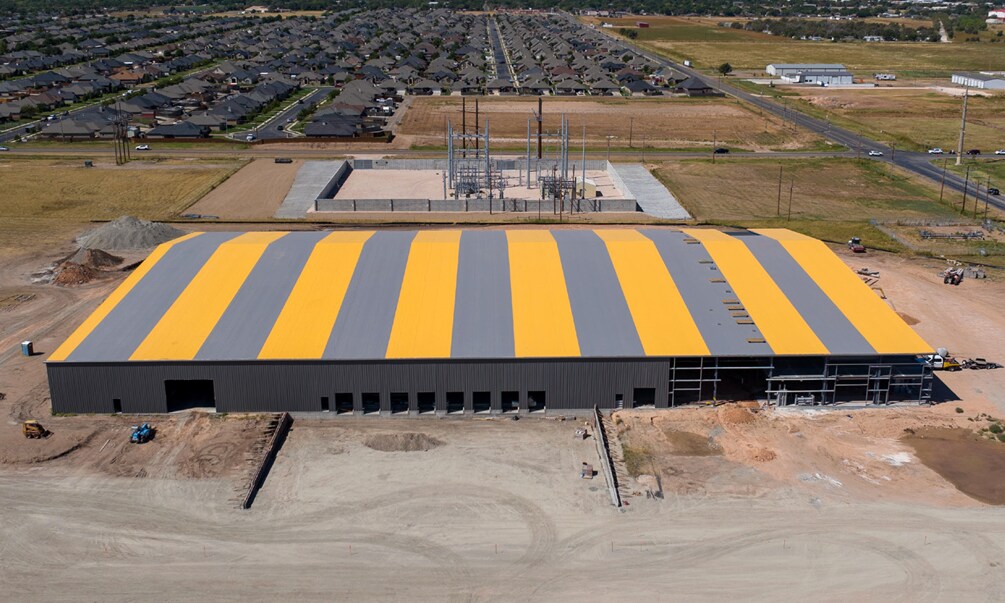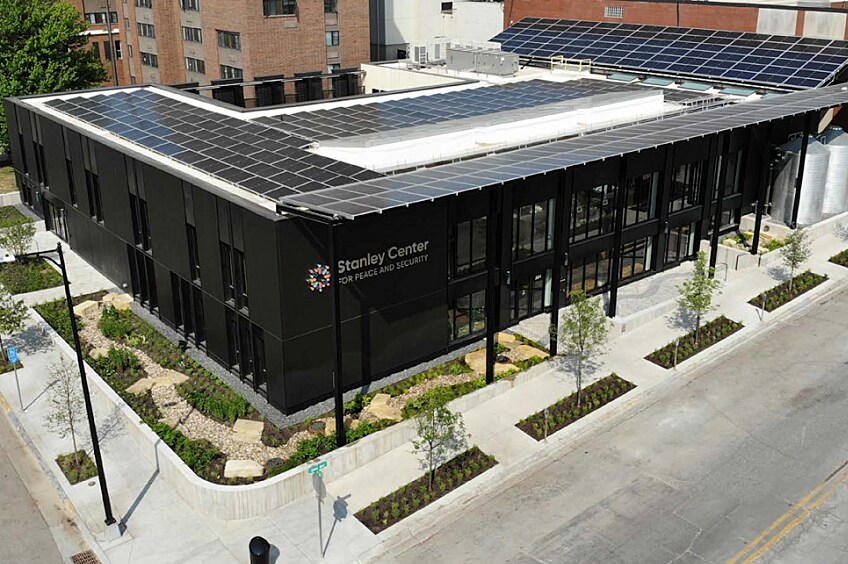Single-ply roof membranes are ubiquitous in the commercial roofing industry, comprising the majority of low-slope roof installations. Their popularity is driven by advantages such as ease of installation, cost-effectiveness, and durability, with some options also offering sustainability benefits.
Here is a breakdown of the most common single-ply roof membrane types including a comparison of their performance, durability, and energy efficiency properties.
Single-Ply Roof Membrane Types and Attributes
The primary types of single-ply roof membranes are thermoplastic polyolefin (TPO), polyvinyl chloride (PVC)/polyvinyl chloride with ketone ethylene ester (PVC KEE), and ethylene propylene diene monomer (EPDM). TPO and PVC membranes consist of three layers:
A base polymer layer
A reinforcement made of polyester or fiberglass
A top cap layer that includes heat and ultraviolet (UV) stabilizers providing weather resistance
These materials are reliant on the thickness and durability of the cap layer for their longevity and performance, so it is important to specify a membrane from a manufacturer you trust.
EPDM membranes have a different structure, consisting of:
An elastomeric base layer
An AFR fire-retardant middle layer
A FRM polyester-fiber reinforced top layer
While these single-ply roof membrane types share similar structures, they differ in chemical composition, attachment methods, chemical resistance, and overall durability.
Thermoset vs. Thermoplastic
One of the most important differences among single-ply roof membrane types is whether they fall into the thermoset or thermoplastic category.
During the manufacturing process, thermoset materials undergo a chemical change that makes them permanently "set" after their initial exposure to heat. They cannot be remolded or re-formed. Thermoplastics, however, can be reheated and fused when exposed to high heat. This allows for welding of seams and detailing membranes.
These differences have implications for each type of membrane. With EPDM, which is a thermoset, the seams must be glued or taped. With TPO, PVC, and PVC KEE, which are thermoplastics, you can weld the seams and detailing membranes, making a monolithic membrane.
TPO
TPO roofing was introduced in the 1980s and standardized in 2003 with first publication of ASTM D6878. Known for its low cost and fast installation, TPO comprises more than 50% of the commercial roof market.* TPO can be attached mechanically, adhered, induction-welded, or adhered. Because it is a thermoplastic, the seams can be heat-welded, providing superior strength and longevity at the laps.
TPO membranes come in varying thicknesses including 45, 60, and 80 mil—with or without fleece backing for additional impact resistance. Most TPO roofs are white, making TPO an excellent choice for cool roof applications in areas where a high Solar Reflectivity Index (SRI) is required.
TPO also comes in many different colors, some that also have high SRI values, which can provide a designer with additional design options such as was used on the Austin Hose building in Amarillo, TX. TPO is flexible without the use of plasticizers, dimensionally stable, and resistant to fungus and many chemicals (except acids, greases, or oils). With 4–10% recycled content, depending on the specific product, GAF TPO roofing also reduces the demand for raw materials. One drawback of TPO is that it is initially less flexible than other membranes such as PVC.

Austin Hose Headquarters, Amarillo, TX. Roofing System: EverGuard® TPO 60-mil Smooth Membrane in a custom Goldenrod yellow and Slate Gray design
In addition to standard TPO, higher performance, extreme TPO membranes are available. These membranes are tested for extended heat aging per ASTM D573-13 and are ideal for high heat and solar applications. For more information on GAF EverGuard® TPO membranes and specifications here.
PVC
PVC roof membranes were first developed in Switzerland and Germany during the 1960s and made their way to the U.S. in the 1970s. As a thermoplastic, PVC offers the advantage of heat-welded seams, similar to TPO, which creates a strong, continuous membrane. They can be installed using mechanical attachment, induction welding, or with adhesive. GAF EverGuard® PVC membranes are available in 50, 60, or 80 mil thicknesses, with optional fleece backing.
PVC is known for its durability and puncture resistance along with fire resistance properties. PVC incorporates a liquid plasticizer, giving it superior flexibility—ideal for roofs with complex contours. It's also dimensionally stable and resistant to most chemicals, including oil and grease. One of the drawbacks of PVC is that it is not compatible with asphaltic materials and can be prone to organic growth under certain conditions.
Available in white and other reflective colors, PVC is another popular choice among single-ply roof membrane types for high-SRI applications. GAF PVC membranes also contain 5% recycled content, offering sustainability benefits in addition to performance.
PVC KEE
Developed in the 1980s, PVC KEE contains a solid plasticizer that enhances flexibility, long-term weatherability, and UV resistance of the membrane. The result is a high-performing, durable cool roof solution. PVC KEE membranes can be mechanically attached, induction welded or adhered. Their chemical and fire resistance is superior to other single-ply roof membrane types. Thanks to their ability to withstand jet fuel, oils, and grease, they're especially well-suited for roofs on restaurants, airports and surrounding buildings, and other facilities with high exposure to harsh contaminants. These additional benefits do come at a higher cost than other single-ply membranes.
GAF EverGuard® PVC KEE membranes are available in the same reflective colors and thicknesses as standard PVC—50, 60, or 80 mil—with or without fleece backing.
EPDM
EPDM is a synthetic rubber product that is naturally black in color. It has been used as a roofing membrane since the 1960s. Today, it accounts for approximately 15% of the commercial roofing market. EPDM ranges in thickness from 45 to 90 mil and can be mechanically attached, ballasted, or adhered. As a thermoset product, EPDM requires seams to be glued or taped rather than heat welded. Due to the inclusion of carbon black, the material has high heat and UV resistance.
A drawback of EPDM is its tendency to shrink and crack over time when exposed to prolonged high temperatures when not properly reinforced. This shrinkage can place additional stress on seams, potentially compromising adhesion. It has limited resistance to acids, grease, and animal or vegetable oils and should not come in contact with asphaltic materials.
Because of its dark color, EPDM absorbs heat, making it a less favorable choice for cool roof applications. While there is the option to laminate white titanium oxide to the top sheet, it's typically more expensive, less durable, and more challenging to seam. Still, EPDM maintains a stronghold in colder, heating dominated climates, especially in areas that do not have consistent snow.
Cost and Life Cycle Considerations
While actual costs vary based on factors like location, roof size and complexity, and membrane type/thickness, some general comparisons can be made. PVC KEE membranes tend to have the highest initial cost. Standard PVC and TPO are generally more affordable, with TPO often being the most cost-effective choice among thermoplastics. EPDM typically has the lowest installation cost, but its seams may require more ongoing maintenance and repairs, potentially increasing long-term expenses.
Warranties vary among the membrane types as well. EPDM warranties typically cover 20 years but may be longer depending on the type of installation. GAF EverGuard® TPO roofs may qualify for warranties ranging from 25 to 35 years, depending on membrane thickness, fleece backing, and installation method and if the Extreme version is selected. GAF EverGuard PVC systems offer warranties up to 30 years, while GAF EverGuard® PVC KEE systems can be eligible for warranties of 30 to 35 years. Overall, lifespan and warranty coverage across single-ply roof membrane types are often comparable. Lifespan is more dependent on membrane thickness rather than membrane type. With an 80 mil TPO, you can get a guarantee similar to a PVC KEE — with the coverage being system-dependent. The membrane thickness and attachment method all come into play.
Membrane Selection and Water Mitigation
Since bulk water from rain and melting snow collects more quickly and drains more slowly than on roofs with a higher slope, low-slope roofs can be susceptible to ponding (standing water), which can result in premature deterioration of the roofing membrane. EPDM, while water-resistant, can degrade when water is allowed to stand for extended periods.
GAF EverGuard TPO, PVC and PVC KEE membranes are durable under ponding water conditions. Tapered polyiso insulation can help improve drainage on low-slope roofs by directing the flow of water to drains. Because of their flexibility, durability, and heat-welded seams, both TPO and PVC work well with tapered insulation. You can contact our tapered design group for more information.
Roof Retrofit Applications
Because TPO and PVC/PVC KEE membranes can be installed more quickly and economically than some other roof systems, they are excellent choices for reroofing existing buildings. Their higher SRI also helps minimize cooling costs, thus improving buildings' energy efficiency.
If an existing built-up roof or modified bitumen roof is in relatively good condition with minimal underlying moisture, a fleece-back TPO or PVC/PVC KEE membrane can be installed as a new top layer without the expense and disruption of tearing off the entire roof. Read this blog for more information on hybrid roof assemblies or get system specific details here.
When choosing between single-ply roof membrane types, it's good to know there are options to suit a wide range of project needs. Whether you're prioritizing chemical resistance, sustainability, or durability under heavy foot traffic, ponding water, or extreme weather, there's a membrane type designed to meet your needs. Learn more about different roofing systems by contacting the Building & Roofing Science Team at buildingscience@gaf.com for support on your specific project questions.
*excluding restoration, metal and LAR

